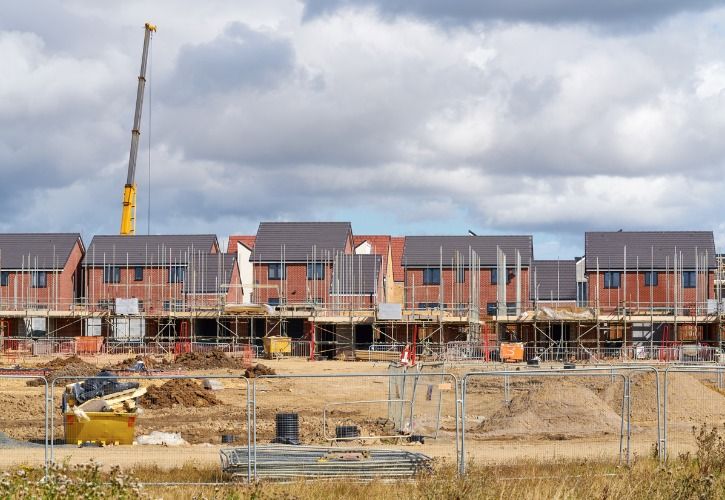UK DIY News
One In Thirteen New Builds In Last Decade Are In Flood Zones

- Analysis reveals one in thirteen (8%) – equivalent to almost 110,000 - new homes in last decade built in flood zone1.
- Crucially, homes built post-2008 are not covered by reinsurance scheme, Flood Re.
- Research reveals three in five (59%)2 new build residents think their home is at risk from flooding.
- Half (50%) new build residents believe climate change will impact their home in the next year, rising to 71% in the next ten years.
- A fifth (19%) are concerned the location of their home is unsuitable due to potential flooding.
- Only a quarter (26%) of new build residents have no concerns about the quality of the build.
New analysis by the UK’s largest home insurer, Aviva, reveals that one in thirteen (8%)1 new homes built in England in the last ten years are in a flood zone, the equivalent of almost 110,000 homes.
Since 2013/14, 1,355,330 new homes have been completed in England1, with 8% - 109,017 homes - built in national flood zone three3, which represents the highest risk from flooding. Some of these properties will be protected by flood defence systems but some locations may have no defences in place. This number excludes 2022/23 where figures are not yet available.
This is despite homes built since 2009 being excluded from the Flood Re reinsurance scheme which was set up in 2016 to improve the affordability and accessibility of flood insurance to homes in high risk areas.
Furthermore, research commissioned by Aviva among residents of homes built in the last five years2 reveals that three in five (59%) believe their home is at risk from flooding, compared with 41% of residents of homes built pre-2018. Worryingly, one in five (19%) new build home residents believe the location of their home is unsuitable due to the potential risk from flooding.
It appears climate concerns also extend beyond flood. Almost two thirds (61%) of new home residents are concerned about the impact of heat on their home, compared with 46% of residents of homes built pre-2018. Storms are also a concern, cited by 62% of new build residents (51% of residents of homes built before 2018).
Jason Storah, CEO UK & Ireland General Insurance, Aviva, said: “It has been heartbreaking to see the devastation caused by flooding during recent winter storms. Sadly, some homes have flooded multiple times and inevitably, many affected properties will be on newer developments.
“It’s concerning that almost 110,000 new homes have been built in the last decade in a flood zone, leaving thousands of homeowners and tenants at risk. Crucially, these homes are not covered by the Flood Re insurance scheme and many may have been constructed without flood resilience. Not only are these newly-built homes at high risk, they also face the prospect of repeated flooding and may not be protected by flood defences to prevent or limit flood damage.
“Insurance can play its part by restoring homes and offering financial reassurance, but it cannot replace cherished family possessions or prevent the emotional impact that floods bring. It is paramount that any future plans for new homes include strengthened rules to prevent the development of buildings in current and potential flood zones. But in some low-lying parts of the country, this is more difficult. In these cases, flood resilience should be made mandatory in planning rules and built in from the outset.”
Many new build homes have experienced some damage since they were built. According to the research, one in eight (13%) new build residents say their home has been affected by flooding inside and 16% of new homes have suffered a flood event in the garden. However, the research also reveals new homes are not just at risk from flooding but wider construction issues.
Over a quarter (26%) have suffered a water leak; 18% have been damaged by storms and one in seven (15%) have been affected by subsidence, severe movement or tree damage.
Echoing this real-life experience, new build residents are also worried about the construction of their home. Over a third (35%) are concerned about the quality of workmanship and 34% worry about the quality of materials. A fifth (21%) are concerned about the lack of resilience in their home. Only a quarter (26%) have no concerns about the quality of the build.
Whilst almost two thirds (60%) of new build home residents are confident their home builder or developer has done enough to protect their home, only half (51%) are aware if measures have been put in place to reduce or prevent flooding.
However, although some new homes may face a greater risk from flooding, the research reveals those living in new homes are more aware of the measures needed to make their property more resilient to climate impacts. Over two in five (42%) agree they know what steps to take to improve resilience and only a quarter (26%) have not installed resilient measures, compared with 60% of residents of homes built pre-2018.
What, if any, concerns do you have over the quality of your house build?
Event | % of new build homeowners |
Quality of workmanship | 35% |
Quality of materials | 34% |
No concerns | 26% |
Insufficient insulation | 24% |
Lack of resilience measures | 21% |
Location unsuitable due to potential flooding | 19% |
Storah added: “It's worrying that many newly-built homes have already suffered a flood within five years of construction. This suggests the homes may have been built in unsuitable locations to standards which are unable to withstand flooding. But the research reveals wider concerns about construction which could leave these homeowners and tenants at risk from other climate events, including hot, dry weather.
“If we are to prevent more scenes of devastation caused by extreme weather, we need to work collectively to change where and how we build. By building houses that are climate-ready and able to withstand the multiple impacts of climate change we can provide safe and sustainable homes for our future generations.”
Financial year | Permanent dwellings completed * England | Proportion (%) of new residential addresses created in Zone 3** England | Number homes built in flood zone 3 (rounded) |
2013/14 | 112,330 | 7 | 7,863 |
2014/15 | 124,640 | 8 | 9,971 |
2015/16 | 139,710 | 8 | 11,177 |
2016/17 | 147,520 | 8 | 11,802 |
2017/18 | 160,910 | 10 | 16,091 |
2018/19 | 169,060 | 8 | 13,525 |
2019/20 | 175,330 | 9 | 15,780 |
2020/21 | 154,630 | 7 | 10,824 |
2021/22 | 171,200 | 7 | 11,984 |
2022/23 | [174,600 -not included] | n/a | n/a |
Total | 1,355,330
| Av = 8 (I in 13) | 109,017 (no figs available for 22/23) |
Table 2b (completed homes)
**Live table 320: https://www.gov.uk/government/statistics/land-use-change-statistics-2021-to-2022
2 .Censuswide survey on behalf of Aviva. 2462 UK respondents, including at least 500 with homes built in the last five years. August 2023.
3 National Flood Zone 3: Land assessed as having a 1 in 100 or greater annual probability of river flooding (>1%), or a 1 in 200 or greater annual probability of flooding from the sea (>0.5%) in any year. Flood Zone 3 ignores the presence of flood defences.
Source : Aviva
Image : Duncan_Andison / istockphoto.com / 1006508302
Thank you for the excellent presentation that you gave at Woodbury Park on Thursday morning. It was very interesting and thought-provoking for our Retail members. The feedback has been excellent.











































